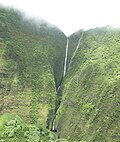Molokai
Molokai is an island in the Hawaiian archipelago. It is part of Maui County, which also includes Maui, Lanai, and Kahoolawe. Molokai is the fifth largest of the main Hawaiian Islands and is known for its rural lifestyle, history, and natural features.
Geography[edit]
Molokai is located east of Oahu and north of Lanai. The island is roughly 38 miles long and 10 miles wide, with a total area of 260 square miles. The highest point on the island is Kamakou on the East End, which reaches 4,970 feet above sea level.
History[edit]
Molokai has a rich history, with evidence of human habitation dating back to AD 650. The island was first settled by Polynesians, who developed a complex society and culture. In the 18th century, the island was united under the rule of Kamehameha I as part of the Kingdom of Hawaii.
Economy[edit]
The economy of Molokai is primarily based on agriculture, with major crops including coffee, macadamia nuts, and papayas. Tourism also plays a significant role, although it is less developed than on other Hawaiian islands.
Culture[edit]
Molokai is known for its strong preservation of native Hawaiian culture. The island is home to the largest population of native Hawaiians in the state, and many residents still practice traditional Hawaiian customs and speak the Hawaiian language.
See also[edit]
|
|
|
Molokai[edit]
-
Map of Hawaii highlighting Molokai
-
East Molokai
-
Halawa Molokai
-
Molokai Light Moloka`i (Kalaupapa), HI Light House
-
Molokai coast with a view of the federal leprosarium
-
The Kalaupapa Leper Settlement
-
Molokai Waterfall
-
Molokai hello
-
Molokai Sea Cliffs
Ad. Transform your life with W8MD's Budget GLP-1 injections from $75


W8MD offers a medical weight loss program to lose weight in Philadelphia. Our physician-supervised medical weight loss provides:
- Weight loss injections in NYC (generic and brand names):
- Zepbound / Mounjaro, Wegovy / Ozempic, Saxenda
- Most insurances accepted or discounted self-pay rates. We will obtain insurance prior authorizations if needed.
- Generic GLP1 weight loss injections from $75 for the starting dose.
- Also offer prescription weight loss medications including Phentermine, Qsymia, Diethylpropion, Contrave etc.
NYC weight loss doctor appointmentsNYC weight loss doctor appointments
Start your NYC weight loss journey today at our NYC medical weight loss and Philadelphia medical weight loss clinics.
- Call 718-946-5500 to lose weight in NYC or for medical weight loss in Philadelphia 215-676-2334.
- Tags:NYC medical weight loss, Philadelphia lose weight Zepbound NYC, Budget GLP1 weight loss injections, Wegovy Philadelphia, Wegovy NYC, Philadelphia medical weight loss, Brookly weight loss and Wegovy NYC
|
WikiMD's Wellness Encyclopedia |
| Let Food Be Thy Medicine Medicine Thy Food - Hippocrates |
Medical Disclaimer: WikiMD is not a substitute for professional medical advice. The information on WikiMD is provided as an information resource only, may be incorrect, outdated or misleading, and is not to be used or relied on for any diagnostic or treatment purposes. Please consult your health care provider before making any healthcare decisions or for guidance about a specific medical condition. WikiMD expressly disclaims responsibility, and shall have no liability, for any damages, loss, injury, or liability whatsoever suffered as a result of your reliance on the information contained in this site. By visiting this site you agree to the foregoing terms and conditions, which may from time to time be changed or supplemented by WikiMD. If you do not agree to the foregoing terms and conditions, you should not enter or use this site. See full disclaimer.
Credits:Most images are courtesy of Wikimedia commons, and templates, categories Wikipedia, licensed under CC BY SA or similar.
Translate this page: - East Asian
中文,
日本,
한국어,
South Asian
हिन्दी,
தமிழ்,
తెలుగు,
Urdu,
ಕನ್ನಡ,
Southeast Asian
Indonesian,
Vietnamese,
Thai,
မြန်မာဘာသာ,
বাংলা
European
español,
Deutsch,
français,
Greek,
português do Brasil,
polski,
română,
русский,
Nederlands,
norsk,
svenska,
suomi,
Italian
Middle Eastern & African
عربى,
Turkish,
Persian,
Hebrew,
Afrikaans,
isiZulu,
Kiswahili,
Other
Bulgarian,
Hungarian,
Czech,
Swedish,
മലയാളം,
मराठी,
ਪੰਜਾਬੀ,
ગુજરાતી,
Portuguese,
Ukrainian












